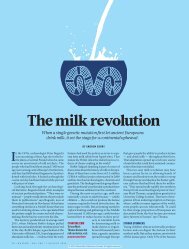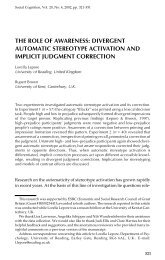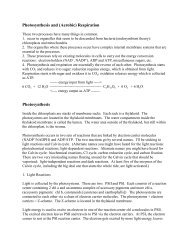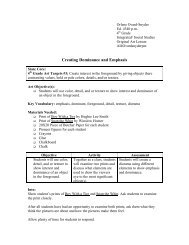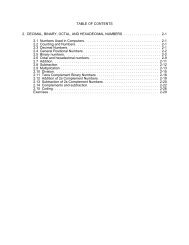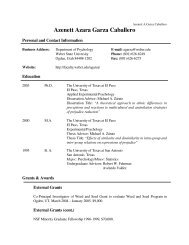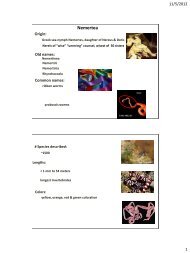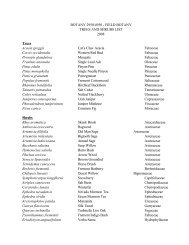Why do almost all mammals have seven cervical vertebrae ...
Why do almost all mammals have seven cervical vertebrae ...
Why do almost all mammals have seven cervical vertebrae ...
Create successful ePaper yourself
Turn your PDF publications into a flip-book with our unique Google optimized e-Paper software.
JOURNAL OF EXPERIMENTAL ZOOLOGY (MOL DEV EVOL) 285:19–26 (1999)<br />
<strong>Why</strong> Do Almost All Mammals Have Seven Cervical<br />
Vertebrae? Developmental Constraints, Hox Genes,<br />
and Cancer<br />
FRIETSON GALIS*<br />
Institute for Evolutionary and Ecological Sciences, University of Leiden,<br />
2300RA Leiden, The Netherlands<br />
ABSTRACT Mammals <strong>have</strong> <strong>seven</strong> <strong>cervical</strong> <strong>vertebrae</strong>, a number that remains remarkably constant.<br />
I propose that the lack of variation is caused by developmental constraints: to wit, changes<br />
in Hox gene expression, which lead to changes in the number of <strong>cervical</strong> <strong>vertebrae</strong>, are associated<br />
with neural problems and with an increased susceptibility to early childhood cancer and stillbirths.<br />
In vertebrates, Hox genes are involved in the development of the skeletal axis and the<br />
nervous system, among other things. In humans and mice, Hox genes <strong>have</strong> been shown also to be<br />
involved in the normal and abnormal (cancer) proliferation of cell lines; several types of cancer in<br />
young children are associated with abnormalities in Hox gene expression and congenital anomalies.<br />
In these embryonal cancers the incidence of a <strong>cervical</strong> rib (a rib on the <strong>seven</strong>th <strong>cervical</strong><br />
vertebra, a homeotic transformation of a <strong>cervical</strong> vertebra towards a thoracic-type vertebra) appears<br />
to be increased. The minimal estimate of the selection coefficient acting against these mutations<br />
is about 12%.<br />
In birds and reptiles variations in the number of <strong>cervical</strong> <strong>vertebrae</strong> <strong>have</strong> frequently occurred<br />
and there is often intraspecific variability. A review of the veterinary literature shows that cancer<br />
rates appear lower in birds and reptiles than in <strong>mammals</strong>. The low susceptibility to cancer in<br />
these classes probably prevents the deleterious pleiotropic effect of neonatal cancer when changes<br />
in <strong>cervical</strong> vertebral number occur.<br />
In <strong>mammals</strong> there is, thus, a coupling between the development of the axial skeleton and other<br />
functions (including the proliferations of cell lines). The coupling of functions is either a conserved<br />
trait that is also present in reptiles and birds, but without apparent deleterious effects, or the<br />
coupling is new to <strong>mammals</strong> due to a change in the functioning of Hox genes. The cost of the<br />
coupling of functions in <strong>mammals</strong> appears to be an increased risk for neural problems, neonatal<br />
cancer, stillbirths, and a constraint on the variability of <strong>cervical</strong> vertebral number. J. Exp. Zool.<br />
(Mol. Dev. Evol.) 285:19–26, 1999. © 1999 Wiley-Liss, Inc.<br />
The exceedingly low level of interspecific variation<br />
in the number of <strong>cervical</strong> <strong>vertebrae</strong> of <strong>mammals</strong><br />
has puzzled biologists for more than 150 years.<br />
In birds, reptiles, and amphibians the number of<br />
<strong>cervical</strong> <strong>vertebrae</strong> varies considerably, and in <strong>mammals</strong><br />
the number of <strong>vertebrae</strong> in other vertebral<br />
regions is variable as well (Lebouck, 1898; Schulz,<br />
’61). Swans’ long necks <strong>have</strong> a striking 22–25 <strong>cervical</strong><br />
<strong>vertebrae</strong>, while ducks <strong>have</strong> 16 (Woolfenden,<br />
’61), and swifts 13 (Starck, ’79). Giraffes and dromedaries,<br />
however, <strong>have</strong> only <strong>seven</strong> <strong>vertebrae</strong> (Fig.<br />
1), as <strong>do</strong> the Dugong (Fig. 2) and whales with their<br />
short necks (Starck, ’79). There are only three genera<br />
with an exceptional number of <strong>cervical</strong> <strong>vertebrae</strong>,<br />
manatees (Trichechus) and sloths (Bradypus<br />
and Choloepus). Thus, there seems to be an evolutionary<br />
constraint towards the development of variability<br />
in the <strong>cervical</strong> region in <strong>mammals</strong>.<br />
Intraspecific variations in the number of <strong>cervical</strong><br />
<strong>vertebrae</strong> in <strong>mammals</strong> are extremely rare,<br />
whereas intraspecific variations in the number of<br />
more caudal <strong>vertebrae</strong> are common, especi<strong>all</strong>y of<br />
the lumbar, sacral, and coccygeal regions (e.g.,<br />
Lebouck, 1898; Schulz, ’61). However, one variation<br />
of <strong>cervical</strong> <strong>vertebrae</strong> <strong>do</strong>es occur infrequently:<br />
<strong>cervical</strong> ribs. A <strong>cervical</strong> rib is on the <strong>seven</strong>th <strong>cervical</strong><br />
vertebra, is a parti<strong>all</strong>y or wholly homeotic<br />
transformation of the <strong>seven</strong>th <strong>cervical</strong> vertebra<br />
into the first thoracic vertebra and, thus, reduces<br />
the number of <strong>cervical</strong> <strong>vertebrae</strong> (and increases<br />
*Correspondence to: Frietson Gailis, Institute for Evolutionary and<br />
Ecological Sciences, University of Leiden, PO Box 9516, 2300RA<br />
Leiden, The Netherlands. E-mail: Galis@rulsfb.leidenuniv.nl<br />
Received 28 October 1998; Accepted 16 December 1998.<br />
© 1999 WILEY-LISS, INC.
20 F. GALIS<br />
Fig. 1. Skeleton of a dromedary (Camelus dromedarius). Note the large <strong>cervical</strong> <strong>vertebrae</strong>.<br />
From Owen (1866).<br />
the number of thoracic <strong>vertebrae</strong>). Further study<br />
of this natur<strong>all</strong>y occurring variation seems relevant<br />
with respect to the evolutionary constraint<br />
on <strong>cervical</strong> vertebral number, and more specific<strong>all</strong>y,<br />
to the study of the selective factors against<br />
this variation.<br />
PATHOLOGIES ASSOCIATED WITH<br />
CERVICAL RIBS<br />
Consideration of the pathologies in humans that<br />
are associated with <strong>cervical</strong> ribs reveals two types,<br />
thoracic outlet syndrome (TOS) and early childhood<br />
cancer. TOS involves pressure on the nerves of the<br />
brachial plexus and on the subclavian artery, sometimes<br />
leading to severe degenerative symptoms in<br />
the arm (Fig. 3; Makhoul and Machleder, ’92; Roos,<br />
’96). Often surgery is performed to relieve symptoms.<br />
Research on this syndrome has revealed that<br />
<strong>cervical</strong> ribs are invariably associated with changes<br />
in the brachial plexus (a different contribution of<br />
motor and sensory nerves to the brachial plexus)<br />
and other structural abnormalities (Makhoul and<br />
Machleder, ’92; Roos, ’96). The correlation of<br />
symptoms must be due to mutual influences of<br />
the notochord, neural tube, neural crest, and<br />
somites at the time of somite formation (Gossler<br />
and Hrabe de Angelis, ’98).<br />
Early childhood cancer is a considerably more<br />
serious pathology. Childhood cancers tend to result<br />
from aberrant developmental processes and<br />
are gener<strong>all</strong>y embryonal in origin. They are associated<br />
with a high incidence of congenital abnormalities.<br />
This association is assumed to be caused<br />
by a common underlying genetic abnormality<br />
Fig. 2. Skeleton of a dugong (Dugong dugon). Note the sm<strong>all</strong> <strong>cervical</strong> <strong>vertebrae</strong>. From<br />
Owen (1866).
CERVICAL VERTEBRAE: HOX GENES AND CANCER 21<br />
Fig. 3. Illustration of the thoracic outlet in a person with<br />
a <strong>cervical</strong> rib showing how arteries and axons are compressed<br />
when the m. anterior scalaenus contracts. The <strong>cervical</strong> rib is<br />
incomplete and fused with the first thoracic rib. (Reproduced<br />
by permission from Adson AW. 1947. Surgical treatment for<br />
symptoms produced by <strong>cervical</strong> ribs and the scalenus anticus<br />
muscle. Surg Gynecol Obstet 85:687–700.)<br />
(Schumacher et al., ’92; Anbazhagan and Raman,<br />
’97). A high incidence of vertebral anomalies, especi<strong>all</strong>y<br />
<strong>cervical</strong> ribs, was found in a study specific<strong>all</strong>y<br />
devoted to finding vertebral anomalies,<br />
of 750 children with embryonal cancers (Schumacher<br />
et al., ’92). An incidence of around 25% <strong>cervical</strong><br />
ribs was found for the following embryonal<br />
cancers: neuroblastoma, brain tumour (astrocytoma<br />
and medulloblastoma), acute lymphoblastic and<br />
myeloid leukemia, soft tissue sarcoma, Wilms’ tumour<br />
and Ewing sarcoma (Table 1). This finding<br />
confirms the observations by Adson and Coffey<br />
(’27), who found that <strong>cervical</strong> ribs are sometimes<br />
discovered in children because of the presence of<br />
a tumor in the neck. In addition, a high correlation<br />
between malformations of ribs (without further<br />
specification) and cancer of <strong>all</strong> types was<br />
found in a large study on childhood cancers (Narod<br />
et al., ’97).<br />
In agreement with the hypothesis of a common<br />
genetic abnormality underlying both early childhood<br />
cancer and <strong>cervical</strong> ribs is the observation<br />
that the relation between congenital anomalies<br />
and cancer is stronger in infants than in older<br />
children (Brodeur, ’95; Breslow et al., ’96; Gurney<br />
et al., ’96). Many infants with cancer demonstrate<br />
unique epidemiologic, clinical, and genetic characteristics<br />
compared with cancers that occur in<br />
older children. Some of the early onset cases are<br />
familial cases, which are rare and gener<strong>all</strong>y characterized<br />
not only by an early onset, but also by a<br />
worse prognosis (Brodeur, ’95; Breslow et al., ’96;<br />
Gurney et al., ’96). This phenomenon is explained<br />
by Knudson’s (’84) model for embryonal childhood<br />
cancers in which two (or only a few) mutational<br />
events occur before the onset of cancer. In familial<br />
cases one of these mutations has occurred in<br />
the germ line and is transmissible to the offspring.<br />
The germ-line mutation has been identified for<br />
familial retinoblastoma (reviewed in Brodeur, ’95).<br />
The timing of mutational events should influence<br />
the incidence and type of congenital anomaly and<br />
these differences in timing can, thus, explain that<br />
not <strong>all</strong> cases of childhood cancer <strong>have</strong> congenital<br />
defects and that the anomalies are variable.<br />
THE ROLE OF HOX GENES IN<br />
PATTERNING OF THE SKELETAL AXIS<br />
AND IN CELL PROLIFERATION<br />
Hox genes play an important role in the patterning<br />
of the axial skeleton in <strong>all</strong> vertebrate<br />
classes (Krumlauf, ’94). Hox gene mutants display<br />
TABLE 1. The incidence of a <strong>cervical</strong> rib in children with embryonal cancers 1<br />
Type of childhood cancer Number of cases Incidence of a <strong>cervical</strong> rib<br />
Neuroblastoma 88 33%<br />
Brain tumour 234 27.4%<br />
Leukemia 227 26.8%<br />
Soft tissue sarcoma 98 24.5%<br />
Wilms tumour 68 23.5%<br />
Ewing sarcoma 35 17.1%<br />
1 Data from Schumacher et al. (’92).
22 F. GALIS<br />
abnormalities of the vertebral column. Particularly<br />
common phenotypic abnormalities in mice<br />
mutants are <strong>cervical</strong> ribs. At least four knock-out<br />
mutants of hox genes in mice <strong>have</strong> an increased<br />
incidence of <strong>cervical</strong> ribs (Hoxa-4, Hoxd-4, Hoxa-<br />
5 and Hoxa-6) (reviewed in Horan et al., 95). In<br />
addition, transgenic mice overexpressing Hoxb-7<br />
or Hoxb-8 and mice mutants lacking the polycombgroup<br />
genes bmi-1 and mel-18 (involved in the<br />
regulation of Hox genes) display <strong>cervical</strong> ribs<br />
(McLain et al., ’92; Charité et al., ’94; Akasaki et<br />
al., ’96; van der Lugt et al., ’96). Thus, the formation<br />
of <strong>cervical</strong> ribs is a process that seems to be<br />
particularly susceptible to perturbations in Hox<br />
gene expression (Horan et al., ’95). Most of these<br />
mutant mice <strong>have</strong> a severely impaired viability.<br />
At the same time Hox genes <strong>have</strong> been shown<br />
to be involved in the proliferation of cell lines in<br />
mice and humans (e.g., Corte et al., ’93; Lawrence<br />
et al., ’96; Anbazhagan et al., ’97). In a study in<br />
which cells of the myeloid, macrophage, erythroid,<br />
and B- and T-lymphoid lingeages were investigated<br />
for expression of homeotic genes, up to 20<br />
different Hox genes were found to be activated<br />
(Kongsuwan et al., ’88). Some of the genes were<br />
ubiquitously expressed, while others were restricted<br />
to particular cell lineages or lines (see also<br />
Lawrence et al., ’96). When the cells were induced<br />
to differentiate, the pattern of Hox gene expression<br />
changed. Changes in Hox gene expression<br />
<strong>have</strong> been demonstrated for several types of cancer,<br />
including some childhood cancers that were<br />
found to <strong>have</strong> a high incidence of vertebral anomalies:<br />
neuroblastoma, Wilms’ tumour, and leukemia<br />
(Corte et al., ’93; Lawrence et al., ’96; Manohar et<br />
al., ’96; Anbazhagan et al., ’97). The coupling between<br />
these two functions of Hox genes is clearly<br />
demonstrated in mice with mutations of the<br />
Polycomb- and trithorax-group genes (Pc-G and<br />
trx-G genes). The evolutionary-conserved Pc-G and<br />
trx-G genes are involved in the maintenance of<br />
expression of homeobox genes including Hom and<br />
Hox genes. Mice lacking or overexpressing Pc-G<br />
and trx-G genes <strong>have</strong> altered expression areas of<br />
Hox genes and display both vertebral anomalies<br />
(including <strong>cervical</strong> ribs and other changes in the<br />
number of <strong>cervical</strong> <strong>vertebrae</strong>) and leukemia or related<br />
cancers (Corte et al., ’93; van der Lugt et al.,<br />
’94; Yu et al., ’95; Akasaki et al., ’96; Schumacher<br />
et al., ’96; Coré et al., ’97). One of these genes is the<br />
trx-G gene Mll, the most commonly involved gene<br />
in infant leukemias (Pui et al., ’95). Mice heterozygous<br />
for the knock-out <strong>all</strong>ele of the caudal gene<br />
Cdx2, which is involved in the regulation of Hox<br />
genes (Epstein et al., ’97), also display both vertebral<br />
abnormalities and a predisposition for intestinal<br />
cancer (He et al., ’97). Furthermore,<br />
rostral overexpression of Hoxb-8 leads to <strong>cervical</strong><br />
ribs in mice, whereas overexpression in bone marrow<br />
is associated with leukemia (Perkins and<br />
Cory, ’93) and overexpression in fibroblasts with<br />
fibrosarcoma (a cancer) (Aberdam et al., ’91).<br />
Thus, in <strong>mammals</strong> Hox genes are involved in<br />
patterning of the skeletal axis and in the proliferation<br />
of cell lines (among other functions) and<br />
aberrations in the regulation of Hox genes may<br />
lead to abnormalities in both these functions.<br />
Selection against <strong>cervical</strong> ribs<br />
The occurrence of <strong>cervical</strong> ribs in various mammalian<br />
species and the particularly frequent occurrence<br />
of <strong>cervical</strong> ribs in experimental mice mutants<br />
indicate that there is not a lack of genetic variation<br />
for this phenotype. Thus, there must be strong stabilizing<br />
selection against the establishment of this<br />
trait. The correlated incidence of <strong>cervical</strong> ribs and<br />
childhood cancer presents a strong case for apparent<br />
selection against <strong>cervical</strong> ribs due to deleterious<br />
pleiotropic effects. This correlation is<br />
strengthened by the mice mutants that not only<br />
display variations in <strong>cervical</strong> vertebral number, but<br />
also <strong>have</strong> cancer and a much reduced fitness<br />
(Akasaki et al., ’96; van der Lugt et al., ’96;<br />
Schumacher et al., ’96; Coré et al., ’97; He et al.,<br />
’97). The incidence of <strong>cervical</strong> ribs in the general<br />
human population averaged over several large studies<br />
(Adson and Coffey, ’27; Etter, ’44; Sycamore, ’44;<br />
Crimm, ’52; Menárguez Carretero and Campo<br />
Muñoz, ’67) is approximately 0.2% (347 cases out<br />
of 220,026; percentages varied from 0.03–0.5). The<br />
frequency of these embryonal cancers added together<br />
in the U.S. and Europe is approximately<br />
0.1% (0.01% Wilms’ tumour (15), 0.033–0.075% leukemia<br />
(Stiller and Parkin, ’96), 0.014% neuroblastoma<br />
(Gurney et al., ’96); braintumours 0.02–0.06%).<br />
Assuming a chance for embryonal cancers of 0.1%<br />
and a chance for <strong>cervical</strong> ribs associated with embryonal<br />
cancers of 25% (Shumacher et al., ’92) implies<br />
a 0.025% chance for children to <strong>have</strong> both a<br />
<strong>cervical</strong> rib and early childhood cancer. Assuming a<br />
frequency of <strong>cervical</strong> ribs of 0.2% in the general<br />
population after early childhood and an average survival<br />
of 60% for early childhood cancers (Miller et<br />
al., ’95) implies that the total incidence of <strong>cervical</strong><br />
ribs at birth is 0.21%, of which 11.9% will develop<br />
an embryonal cancer. This suggests that children<br />
with embryonal cancers <strong>have</strong> a 125-fold increased<br />
incidence of <strong>cervical</strong> ribs (25% vs. 0.2%), and that
CERVICAL VERTEBRAE: HOX GENES AND CANCER 23<br />
children born with a <strong>cervical</strong> rib <strong>have</strong> an <strong>almost</strong><br />
120-fold chance of early childhood cancer (11.9% vs.<br />
0.1%). Thus, neonatal cancer alone seems to present<br />
sufficient apparent selection against the establishment<br />
of <strong>cervical</strong> ribs.<br />
In addition, the symptoms of TOS will enhance<br />
natural selection against <strong>cervical</strong> ribs by direct<br />
stabilizing selection. The seriousness of the symptoms<br />
is correlated with the amount of manual<br />
labour that is being performed. Therefore, under<br />
natural circumstances the selective disadvantage<br />
will be larger than in the sheltered present-day<br />
human environment. Adults with a rudimentary<br />
first rib (a partial transformation towards eight<br />
<strong>cervical</strong> <strong>vertebrae</strong>) often <strong>have</strong> TOS, suggesting<br />
natural selection against this variation in <strong>cervical</strong><br />
vertebral number as well (Gelabert et al., ’97).<br />
A further selection factor against <strong>cervical</strong> ribs<br />
could be an increased chance of stillbirths. A large<br />
minority (>30%) of fetuses between 49 and 150 mm<br />
has ossification centers in the <strong>seven</strong>th <strong>cervical</strong><br />
prevertebra (Peters, ’27; Noback, ’51; Meyer, ’78).<br />
These ossification centers appear in the same position<br />
as those of thoracic pre<strong>vertebrae</strong>’s future ribs.<br />
An explanation of this phenomenon could be that<br />
the high percentage of ossification centers (<strong>cervical</strong><br />
ribs) is related to the causes that <strong>have</strong> led to the<br />
premature death of these fetuses. Again the interactive<br />
nature of the early processes which involve<br />
Hox genes may present a link between <strong>cervical</strong> ribs<br />
and other abnormalities, as it is unlikely that the<br />
ossification centers themselves cause stillbirths. It<br />
is possible that the problems in the proliferation of<br />
cell lines that lead to neonatal cancer are also caus<strong>all</strong>y<br />
related to the stillbirths.<br />
A COMPARISON OF MAMMALS,<br />
REPTILES AND AMPHIBIANS<br />
The number of <strong>cervical</strong> <strong>vertebrae</strong> is variable in<br />
amphibians, reptiles, and birds, in strong contrast<br />
to <strong>mammals</strong> (in fishes no <strong>cervical</strong> vertebral region<br />
is distinguished). The selection against such<br />
variation in the number of <strong>cervical</strong> <strong>vertebrae</strong> must<br />
be considerably weaker or absent in these other<br />
vertebrate classes. In necropsy studies of zoo animals,<br />
cancer rates of birds and reptiles are low<br />
compared to <strong>mammals</strong> (Fox, ’12; Ratcliffe, ’33;<br />
Ippen, ’59; Lombard and Witte, ’59; Effron et al.,<br />
’77). The low susceptibility to cancer in reptiles<br />
makes intuitive sense because of their low metabolic<br />
rate, which leads to an expectation of low<br />
oxidative DNA damage (cf. Adelman et al., ’88;<br />
Perez-Campo et al., ’98). The low susceptibility in<br />
birds may seem surprising given their high metabolic<br />
rate (McNab, ’88; Ricklefs et al., ’96). However,<br />
there is evidence (from canaries and pigeons)<br />
that birds <strong>have</strong> a remarkably low free radical production<br />
and, thus, a low amount of oxidative damage<br />
(Perez-Campo, ’98).<br />
In addition, cancer in birds, especi<strong>all</strong>y in young<br />
birds, is gener<strong>all</strong>y believed in the majority of cases<br />
to be induced by viruses (Effron et al., ’77; Reece,<br />
’96; Mis<strong>do</strong>rp and Kik, personal communication).<br />
In <strong>mammals</strong> viral cancers are estimated to occur<br />
in 15% of cases, mainly liver cancer, <strong>cervical</strong> cancer,<br />
and Hodgkin’s disease in children (Pisani et<br />
al., ’97). A survey of 343,600 young chickens<br />
showed that none developed a non-vir<strong>all</strong>y associated<br />
cancer in the first five weeks of life whereas<br />
53 developed a vir<strong>all</strong>y associated cancer (Helmsley,<br />
’66). This pattern, confirmed by Reece (’96), is in<br />
striking contrast to that in human infants where<br />
in the first month of life <strong>almost</strong> <strong>all</strong> cancers are nonvir<strong>all</strong>y<br />
associated embryonal cancers, pre<strong>do</strong>minantly<br />
neuroblastoma (35%; Gurney et al.,’96).<br />
In reptiles the viral induction of cancer has been<br />
studied much less. However, reptilian cancers<br />
seem more similar to cancers in birds than in<br />
<strong>mammals</strong> (Effron et al., ’77) and the viruses that<br />
induce cancer in reptiles also seem more similar<br />
to those in birds than in <strong>mammals</strong> (Trubcheninova<br />
et al., ’77). In addition, reptiles with cancer at<br />
necropsy are usu<strong>all</strong>y very old, and one study has<br />
shown that snakes with cancer are even older on<br />
average than snakes without cancer (Ramsay et<br />
al., ’96). In amphibians the situation is even less<br />
well <strong>do</strong>cumented; however, the one type of cancer<br />
that is well <strong>do</strong>cumented, Lucké’s tumour in Rana<br />
pipiens, is a vir<strong>all</strong>y induced cancer (McKinnell and<br />
Carlson, ’97).<br />
There are a few mammalian species with an aberrant<br />
number of <strong>cervical</strong> <strong>vertebrae</strong>: manatees and<br />
sloths. Sloths especi<strong>all</strong>y show a spectacular break<strong>do</strong>wn<br />
of the constraint on variation as the number<br />
of <strong>cervical</strong> <strong>vertebrae</strong> varies from 6 to 9 (Giffin<br />
and Gillett, ’96). There is no explanation for these<br />
exceptions, but I suggest as hypothesis that the<br />
extremely low metabolic rate of manatees and<br />
sloths (e.g., McNab ’88; G<strong>all</strong>ivan and Best ’89;<br />
Koteja ’91; Hammond and Diamond, ’97) is associated<br />
with low oxidative DNA damage and, thus,<br />
with a low susceptibility to cancer (Adelman et<br />
al., ’88; Shigenaga and Ames, ’93). This hypothesis<br />
needs to be tested.<br />
CONCLUSIONS<br />
It appears, therefore, that the cause of the conservation<br />
of <strong>seven</strong> <strong>cervical</strong> <strong>vertebrae</strong> should be
24 F. GALIS<br />
sought (1) in a genetic link between early childhood<br />
cancer and stillbirths and variation in <strong>cervical</strong><br />
<strong>vertebrae</strong> number, and (2) in the neuronal<br />
problems leading to the thoracic outlet syndrome<br />
in adults associated with <strong>cervical</strong> ribs. The involvement<br />
of Hox genes in the cancers that are<br />
associated with <strong>cervical</strong> ribs in mice and men<br />
points to a coupling between functions of Hox<br />
genes that appears to be lacking in birds, reptiles,<br />
and amphibians, or at least has no apparent consequences<br />
when <strong>cervical</strong> vertebral number is<br />
changed. There are two possible explanations for<br />
the observed coupling in <strong>mammals</strong>: (1) the coupling<br />
of functions of Hox genes has newly appeared<br />
in <strong>mammals</strong> due to a change in the<br />
functioning of Hox genes (e.g., a new function in<br />
proliferation in <strong>mammals</strong>); and (2) the coupling<br />
of functions was already present in reptiles, but<br />
hidden because of the low susceptibility to cancer.<br />
This coupling has only become detectable in<br />
<strong>mammals</strong> because of an increase in susceptibility<br />
to cancer. And this increase in cancer susceptibility<br />
can be the direct result of the increase in metabolic<br />
rate, which is associated with an increase in<br />
oxidative damage (Adelman et al., ’88; Shigenaga<br />
and Ames, ’93).<br />
The increase in cancer susceptibility and the<br />
presumed increase in stillbirths are pleiotropic<br />
deleterious effects, whereas the neuronal problems<br />
are a direct consequence of the change in<br />
<strong>cervical</strong> vertebral number. The fact that the pleiotropic<br />
effect of cancer recurs for what presumably<br />
are a large number of different mutations<br />
<strong>all</strong>ows us to classify these collectively as a developmental<br />
constraint. To further understand the<br />
constraint on changes in the number of <strong>cervical</strong><br />
<strong>vertebrae</strong> that exists in virtu<strong>all</strong>y <strong>all</strong> <strong>mammals</strong>, a<br />
study of the function of Hox genes in cell proliferation<br />
and carcinogenesis in birds, reptiles, and<br />
amphibians is urgently needed. Furthermore, it<br />
should be an interesting experiment to select for<br />
complete <strong>cervical</strong> ribs in a mammalian species to<br />
see whether a healthy strain can be produced, or<br />
whether this would lead to the predicted increase<br />
in susceptibility for cancer, stillbirths, and neuronal<br />
problems.<br />
ACKNOWLEDGMENTS<br />
I thank Hans Metz, Rogier Versteeg, Günter<br />
Wagner, Jacques van Alphen, and Adam Wilkins<br />
for stimulating discussions and ideas, and Maja<br />
Kik, Elliott Jacobson, Hans Feuth, and Professor<br />
Mis<strong>do</strong>rp for medical and veterinary information.<br />
Russ Lande, Gerard Mulder, Louise Roth, Menno<br />
Schilthuizen, Jan Sevenster, Elisabeth van Ast-<br />
Gray, Günter Wagner, Adam Wilkins, Ole Seehausen<br />
and an anonymous referee gave many<br />
helpful comments on the manuscript. Thanks to<br />
David Povel and Frank Alders for their help in<br />
collecting literature and to Adri ’t Hooft and Martin<br />
Brittijn for help with the figures.<br />
LITERATURE CITED<br />
Aberdam D, Negreanu V, Sachs L, Blatt C. 1991. The oncogenic<br />
potential of an activated Hox-2.4 homeobox gene in<br />
mouse fibroblasts. Mol Cell Biol 11:554–557.<br />
Adelman R, Saul RL, Ames BN. 1988. Oxidative damage to<br />
DNA: relation to species metabolic rate and life span. Proc<br />
Natl Acad Sci USA 85:2706–2708.<br />
Adson AW. 1947. Surgical treatment for symptoms produced<br />
by <strong>cervical</strong> ribs and the scalenus anticus muscle. Surg<br />
Gynecol Obstet 85:687–700.<br />
Adson AW, Coffey JR. 1927. Cervical rib. Ann Surg 85:<br />
839–857.<br />
Akasaki T, Kanno M, B<strong>all</strong>ing R, Mieza MA, Taniguchi M,<br />
Koseki HA. 1996. A role for mel-18, a polycomb group–related<br />
vertebrate gene, during the anteroposterior specification<br />
of the axial skeleton. Development 122:1513–1522.<br />
Albertazzi E, Cajone F, Lakshmi MS, Sherbet GV. 1998. Heat<br />
shock modulates the expression of the metastasis associated<br />
gene MTS1 and proliferation of murine and human<br />
cancer cells. DNA Cell Biol 17:1–7.<br />
Alkema MJ, Lugt NMT, Bobeldijk RC, Berns A, van Lohuizen<br />
M. 1995. Transformation of axial skeleton due to overexpression<br />
of bmi-1 in transgenic mice. Nature 374:724–727.<br />
Anbazhagan R, Raman V. 1997. Homeobox genes: molecular<br />
link between congenital anomalies and cancer. Eur J Cancer<br />
33:635–637.<br />
Bardeen CR. 1904. Numerical vertebral variation in the human<br />
adult and embryo. Anat Anz 25:497–519.<br />
Breslow NE, Olsen J, Moksness J, Beckwith JB, Grundy P.<br />
1996. Familial Wilms’ tumor: a descriptive study. Med<br />
Pediatr Oncol 27:398–403.<br />
Brodeur GM. 1995. Genetics of embryonal tumours of childhood:<br />
retinoblastoma, Wilms’ tumour and neuroblastoma.<br />
Cancer Surv 25:67–99.<br />
Charité J, de Graaff W, Deschamps J 1994. Ectopic expression<br />
of Hoxb-8 causes duplication of the ZPA in the forelimb<br />
and homeotic transformation in axial structures. Dev<br />
Dyn 204:13–21<br />
Crimm PD. 1952. Evaluation of a five year minifilm program.<br />
Am J Roentg 68:240–246.<br />
Coré N, Bel S, Gaunt SJ, Aurrand-Lions M, Pearce J, Fisher<br />
A, Djabali M. 1997. Altered cellular proliferation and mesoderm<br />
patterning in Polycomb-M33-deficient mice. Development<br />
124:721–729.<br />
Corte G, Airoldi I, Briatat P, Corsetti MT, et al. 1993. The<br />
homeotic gene products in the control of cell differentiation<br />
and proliferation. Cancer Detect Prev 17:261–266.<br />
Dongen PAM van. 1998. Brain size in vertebrates. In:<br />
Nieuwenhuys R, ten Donkelaar HJ, Nicholson C, editors.<br />
The central nervous system of vertebrates, volume 3. Berlin:<br />
Springer Verlag. p 2099–2134.<br />
Effron M, Griner L, Benirschke K. 1977. Nature and rate of<br />
neoplasia in captive wild <strong>mammals</strong>, birds and reptiles at<br />
necropsy. J Natl Cancer Inst 59:185–198.<br />
Epstein M, Pillemer G, Yelin R, Yisraeli JK, Fainsod A. 1997.
CERVICAL VERTEBRAE: HOX GENES AND CANCER 25<br />
Patterning of the embryo along the anterior-posterior axis:<br />
the role of the caudal genes. Development 124:3805–3814.<br />
Etter LE. 1944. Osseous abnormalities of the thoracic cage<br />
seen in forty thousand consecutive chest photoroentgenograms.<br />
Am J Roentg 5:359–363.<br />
Fox H. 1912. Observations upon neoplasms in wild animals<br />
in the Philadelphia Zoological Gardens. J Path Bact 17:217.<br />
Gelabert HA, Machleder HI. 1997. Diagnosis and management<br />
of arterial compression at the thoracic outlet. Ann Vasc<br />
Surg 11:359–366.<br />
Gossler A, Hrabe de Angelis M. 1998. Somitogenesis. Curr<br />
Top Dev Biol 38:225–287.<br />
Gurney JG, Davis S, Severson RK, Fang J-Y, Ross JA, Robison<br />
LL. 1996. Trends in cancer incidence among children in the<br />
U.S. Cancer 78:532–541.<br />
He T-C, Costa LT, Thiagalingam S. 1997. Homeosis and polyposis:<br />
a tale from the mouse. Bioessays 19:551–555.<br />
Helmsley LA. 1966. The incidence of tumours in young chickens.<br />
J Path Bact 92:91–96.<br />
Hoeven F van der, Sordino P, Fraudeau N, Izpisúa-Belmonteand<br />
JC, Duboule D. 1996. Teleost HoxD and HoxA genes:<br />
comparison with tetrapods and functional evolution of the<br />
HoxD complex. Mech Dev 54:9–21.<br />
Horan GSB, Nagy Kovacs E, Behringer RR, Featherstone MS.<br />
1995. Mutations in paralogous Hox genes result in overlapping<br />
homeotic transformations of the axial skeleton: evidence<br />
for unique and redundant function. Dev Biol 169:<br />
359–372.<br />
Ippen R. 1985. Geschwülste. In: Ippen R, Zwart P, Schröder<br />
H-D, editors. Handbuch der zootierkrankheiten, band 1,<br />
reptilien. Berlin: Akademie-Verlag. p 270–301.<br />
Knudson AG. 1984. Genetic predisposition to cancer. Cancer<br />
Det Prev 7:1–8.<br />
Kongsuwan K, Webb E, Housiaux P, Adams JM 1988. Expression<br />
of multiple homeobox genes within diverse mammalian<br />
haematopoietic lineages. EMBO J 7:2131–2138.<br />
Krumlauf R. 1994. Hox genes in vertebrate development.Cell<br />
78:191–201.<br />
Kusewitt DF, Reece RL, Miska KB. 1997. S-100 immunoreactivity<br />
in melanomas of two marsupials, a bird, and a reptile.<br />
Vet Pathol 34:615–618.<br />
Lawrence HJ, Sauvageau G, Humphries RK, Largman C.<br />
1996. The role of Hox homeobox genes in normal and leukemic<br />
hematopoiesis. Stem Cells 14:281–291.<br />
Leboucq H 1898. Recherches sur les variations anatomiques<br />
de la première côte chez l’homme. Archiv Biol 15:9–178.<br />
Lombard LS, Witte EJ. 1959. Frequency and types of tumors<br />
in <strong>mammals</strong> and birds of the Philadelphia zoological<br />
garden. Cancer Res 19:127–141.<br />
Lugt NMT van der, Domen J, Linders K, van Roon M,<br />
Robanus-Maan<strong>do</strong>g E, Riele H, van der Valk M, Deschamps<br />
Y, Sofronio M, van Gohuinen M, Berns A. 1996. Posterior<br />
transformation, neurological abnormalities, and severe hematopoietic<br />
defects in mice with a targeted deletion of the<br />
bmi-1 proto-oncogene. Genes Dev 8:757–769.<br />
Makhoul RG, Machleder HI. 1992. Developmental anomalies<br />
at the thoracic outlet: an analysis of 200 consecutive cases.<br />
J Vasc Surg 16:534–545.<br />
Manohar CF, Salwen HR, Furta<strong>do</strong> MR, Cohn SL. 1996. Upregulation<br />
of Hoxc6, Hoxd1, and Hoxd8 homeobox gene expression<br />
in human neuroblastoma cells following chemical<br />
induction of differentiation. Tumor Biol 14:34–47.<br />
McLain K, Schreiner C, Yager KL, Stock JL, Potter SS. 1992.<br />
Ectopic expression of Hox-2.3 induces craniofacial and skeletal<br />
malformations in transgenic mice. Mech Dev 39:3–16.<br />
Maris JM, Brodeur GM. 1997. Are certain children more likely<br />
to develop neuroblastoma? J Pediatr 131:656–657.<br />
McKinnell RG, Carlson DL. 1997. Lucké renal adenocarcinoma,<br />
an anuran neoplasm: studies at the interface of pathology,<br />
virology, and differentiation competence. J Cell<br />
Physiol 173:115–118.<br />
McNab BK. 1983. Energetics, body size, and the limits to<br />
en<strong>do</strong>thermy. J Zool Lond 199:1–29.<br />
Meyer DB. 1978. The appearance of ‘<strong>cervical</strong> ribs’ during early<br />
human fetal development. Anat Rec 190:481.<br />
Menárguez Carretero L, Campo Muñoz M. 1967. Estudio<br />
radiologico y tipos morfologicos de costillas <strong>cervical</strong>es en el<br />
sexo femenino. Enferm Torax 16:285–308.<br />
Miller RW, Young JL, Novakovic B. 1995. Childhood cancer.<br />
Cancer 75(suppl):395–405.<br />
Narod SA, Hawkins MM, Robertson CM, Stiller CA. 1997.<br />
Congenital anomalies and childhood cancer in Great Britain.<br />
Am J Hum Genet 60:474–485.<br />
Noback CR, Robertson GG. 1951. Sequences of appearance<br />
of ossification centers in the human skeleton during the<br />
first five prenatal months. Am J Anat 89:1–28.<br />
Perez-Campo R, López-Torres M, Cadenas S, Rojas C, Barja<br />
G. 1998. The rate free radical production as a determinant<br />
of the rate of aging: evidence from the comparative approach.<br />
J Comp Physiol B 168:149–158.<br />
Perkins AC, Cory S. 1993. Conditional immortalization of mouse<br />
myelomonocytic megakaryocytic and mast cell progenitors by<br />
te Hox-2.4 homeobox gene. EMBO J 12:3835–3846.<br />
Peters H. 1927. Varietäten der Wirbelsäule menschlicher<br />
Embryonen. Gegenbaurs Morph Jahrbuch 58:440–477.<br />
Pisani P, Parkin DM, Muñoz M, Ferlay J. 1997. Cancer and<br />
infection: estimates of the attributable fraction in 1990. Cancer<br />
Epidemiol Biomarkers Prev 6:387–400.<br />
Pui C-H, Kane JR, Crist WM. 1995. Biology and treatment<br />
of infant leukemias. Leukemia 9:762–769.<br />
Ramsay EC, Munson L, Lowenstine L, Fowler L, Fowler ME.<br />
1996. A retrospective study of neoplasia in a collection of<br />
captive snakes. J Zoo Wildl Medicine 27:28–34.<br />
Ratcliffe HL. 1933. Incidence and nature of tumors in captive<br />
wild <strong>mammals</strong> and birds. Am J Cancer 17:116–135.<br />
Reece RL. 1996. Some observations on natur<strong>all</strong>y occurring<br />
neoplasms of <strong>do</strong>mestic fowls in the state of Victoria Australia<br />
1977–1987. Avian Pathol 25:407–447.<br />
Ricklefs RE, Konarzeweski M, Daan S. 1996. The relationship<br />
between basal metabolic rate and daily energy expenditure<br />
in birds and <strong>mammals</strong>. Am Nat 147:1047–1071.<br />
Roos DB. 1996. Historical perspectives and anatomic considerations.<br />
Semin Thorac Cardiovasc Surg 8:183–189.<br />
Satgé D, Sasco AJ, Carlsen NLT, Stiller CA, et al. 1998. A<br />
lack of neuroblastoma in Down Syndrome: a study from 11<br />
European countries. Cancer Res 58:448–452.<br />
Schulz AH. 1961. Vertebral column and thorax. In: Hofer H,<br />
Schultz AH, Starck D, editors. Primatologia, handbook of<br />
primatology. S. Karger. p 5/1–5/66.<br />
Schumacher A, Faust C, Magnuson T. 1996. Positional cloning<br />
of a global regulator of anterior-posterior patterning in<br />
mice. Nature 383:250–253.<br />
Schumacher R, Mai A, Gutjahr P. 1992. Association of rib<br />
anamalies and malignancy in childhood. Eur J Pediatr<br />
151:432–434.<br />
Shigenaga MK, Ames BN. 1993. Oxidants and mitogenesis<br />
as causes of mutation and cancer: the influence of<br />
diet. In: Bronzetti G, editor. Antimutagenesis and anticarcinogenesis<br />
mechanisms III. New York: Plenum Press.<br />
p 419–436.
26 F. GALIS<br />
Starck D. 1979.Vergleichende Anatomie der Wirbeltiere. Berlin:<br />
Springer Verlag.<br />
Stiller CA, Parkin DM. 1996. Geographic and ethnic variations<br />
in the incidence of childhood cancer. Brit Med Bull<br />
52:682–703.<br />
Sycamore LK. 1944. Common congenital anomalies of the<br />
bony thorax. Am J Roentg 51:593–599.<br />
Trubcheninova LP, Khutoryansky AA, Svet-Moldavsky GJ,<br />
Kuznetsova LE, et al. 1977. Body temperature and tumor<br />
virus infection: tumorigenicity of Rous sarcoma virus for<br />
reptiles. Neoplasma 24:3–19.<br />
Turner HN. 1847. Observations on the distinction between<br />
the <strong>cervical</strong> and <strong>do</strong>rsal <strong>vertebrae</strong> in the class mammalia.<br />
Proc Zool Soc Lond 15:110–114.<br />
Woolfenden GE. 1961. Postcranial morphology of the waterfowl.<br />
Bull Florida State Museum Biol Sci 6:1–129.<br />
Yu BD, Hess JL, Horning SE, Brown GA, Korsmeyer SJ. 1995.<br />
Altered Hox expression and segmental identity in Mll-mutant<br />
mice. Nature 387:505–508.




